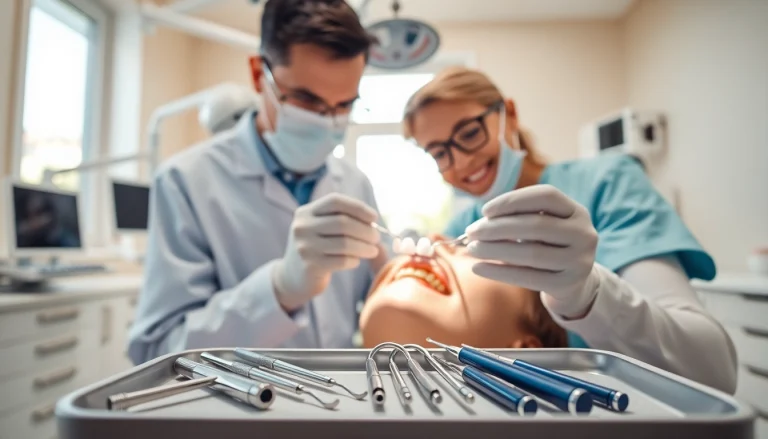
What Are Dental Cleanings?
Definition and Purpose of Dental Cleanings
Dental cleanings are professional procedures designed to maintain oral health by removing plaque, tartar, and bacteria that accumulate on teeth and gums. These preventive measures are key components in oral hygiene that help patients avoid more significant dental issues such as cavities, gum disease, and tooth loss. According to the American Dental Association, regular dental cleanings are essential for everyone, as they ensure teeth remain healthy and functional throughout one’s lifetime.
A dental cleaning typically consists of a series of steps aimed at improving the health of both the teeth and surrounding gum tissue. These sessions enable dentists and hygienists to monitor changes in oral health and make necessary recommendations for ongoing care.
Common Procedures Involved in Dental Cleanings
The dental cleaning process generally includes several steps aimed at ensuring thorough care:
- Initial Examination: A dental hygienist will conduct a visual examination of your mouth, looking for any signs of gum disease or cavities.
- Scaling: This process involves using special instruments to remove plaque and tartar buildup on the teeth’s surface, especially in hard-to-reach areas.
- Polishing: After scaling, the teeth are polished to remove any remaining plaque and to create a smooth surface that is less likely to accumulate stains.
- Flossing: The dental hygienist will then floss between teeth to ensure that any food particles or plaque left behind during scaling are removed.
- Fluoride Treatment: Depending on individual needs, a fluoride treatment may be applied to strengthen tooth enamel and help prevent cavities.
Frequency of Dental Cleanings for Optimal Oral Health
It is generally recommended that adults undergo dental cleanings at least twice a year, although some individuals may benefit from more frequent visits. Those with specific dental concerns such as gum disease may require cleaning every three to four months. Regular cleanings are critical not just for maintaining a healthy smile but also for identifying potential issues early, before they escalate into more significant problems.
Benefits of Regular Dental Cleanings
Impact on Gum Health and Disease Prevention
One of the most significant benefits of regular dental cleanings is the positive impact on gum health. Gum disease, which can lead to tooth loss if untreated, is primarily caused by a buildup of plaque that hardens into tartar. During a cleaning, this harmful accumulation is removed, significantly reducing the risk of periodontal disease. Regular dental cleanings have been shown to lower the levels of bacteria in the mouth, contributing to better overall gum health and reducing inflammation.
Enhancing Overall Oral Hygiene Practices
Dental cleanings play a crucial role in reinforcing good oral hygiene practices. These visits help patients understand the importance of daily brushing and flossing, and hygienists often provide personalized recommendations based on individual needs. Educating patients about effective techniques and proper tool usage ensures enhanced maintenance of oral health at home.
Saving Costs on Future Dental Procedures
Investing in regular dental cleanings can lead to significant cost savings in the long run. By preventing cavities and gum disease, patients can avoid more extensive and costly treatments such as fillings, root canals, or even tooth extractions. The economic benefit of preventative care underscores the value of prioritizing routine cleanings as part of an overall health strategy.
Types of Dental Cleanings Explained
Standard Dental Cleanings
Standard dental cleanings, often referred to as prophylaxis, are what most patients experience during routine visits. They are intended for individuals who maintain a generally healthy oral environment and require basic maintenance to prevent problems. These cleanings typically involve the steps outlined above and are effective for keeping plaque and tartar buildup in check.
Deep Cleanings for Periodontal Health
For patients exhibiting signs of gum disease, deep cleanings—also known as scaling and root planing—may be necessary. This more intensive cleaning not only targets plaque and tartar on the tooth surfaces but also below the gum line. The dental professional cleans out the roots to help the gums reattach to the teeth, improving oral health and reversing some effects of gum disease over time.
Specialized Cleanings for Different Patient Needs
Certain patients may require specialized dental cleanings tailored to their unique health situations. For instance, individuals with braces need more frequent cleanings to combat plaque buildup around brackets and wires. Similarly, patients undergoing chemotherapy or with specific medical conditions might need customized cleaning protocols to suit their sensitive oral environments. Understanding the various needs is essential for effective dental care across diverse patient demographics.
What to Expect During Your Dental Cleaning Appointment
Initial Examination and Assessment
Upon arrival for your dental cleaning appointment, expect to first undergo a comprehensive examination. The dental hygienist taps into a thorough assessment, checking for any signs of decay, gum disease, or other oral health issues. This visual inspection is vital for establishing a baseline before proceeding to the cleaning itself.
Cleaning Process: Tools and Techniques
The actual cleaning process will utilize a variety of specialized tools and techniques. The most common instruments include hand-held scalers and ultrasonic devices. Ultrasonic tools are particularly effective in breaking up tartar, while manual scalers give the hygienist control in sensitive areas. Many health systems are now adopting newer technologies such as dental lasers, which offer minimally invasive options for both cleaning and treatment.
Post-Cleaning Care and Recommendations
After the cleaning, your hygienist may provide specific aftercare recommendations. This could include guidance on proper brushing and flossing techniques, dietary adjustments to promote oral health, or instructions for using mouth rinses to reduce bacteria in the mouth. It’s essential to understand these care tips, as they play a crucial role in maintaining the benefits achieved during the cleaning process.
Addressing Common Concerns About Dental Cleanings
Why Some People Fear Dental Cleanings
The fear of dental cleanings is a common concern among many patients. Factors such as anxiety about pain or discomfort, past negative experiences, and fear of dental instruments contribute to this apprehension. Recognizing and addressing these fears is critical for both patients and dental professionals.
Managing Discomfort During the Procedure
Dental hygienists are trained to help manage patients’ comfort during cleanings. They may use numbing agents, provide breaks during the process, or use specialized instruments designed to minimize discomfort. Additionally, communication between the patient and dental professional is key; voicing concerns allows for tailored adaptations to the cleaning process.
Reassurance About the Necessity of Dental Cleanings
It is crucial to understand that regular dental cleanings are not just routine—they are vital for maintaining long-term oral health. They diminish the risk of severe medical conditions, including heart disease, and can enhance one’s quality of life overall. Providing patients with data and testimonials can help reassure them about the importance of these visits and encourage consistent oral health practices.





